
a.
To find: The positive integer appears the least number of times.
The positive integer appears the least number of times is
Given information:
Consider the patterns in Pascal’s triangle.
Calculation:
The Pascal’s triangle is given by,
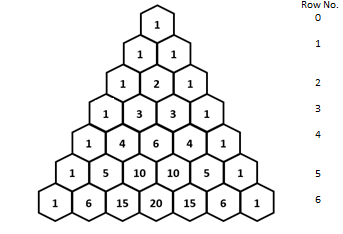
The smallest number that is not
Therefore, the positive integer appears the least number of times is
b.
To find: The numbers that appears the greatest number of times.
The numbers that appears the greatest number of times is
Given information:
Consider the patterns in Pascal’s triangle.
Calculation:
The Pascal’s triangle is given by,
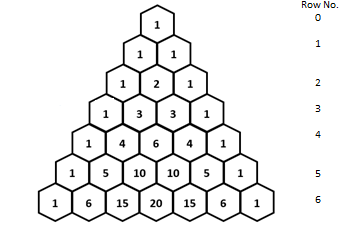
The number
Therefore, the numbers that appears the greatest number of times is
c.
To find: Whether any positive integer that does not appear in Pascal’s triangle?
Every positive integer appears in the Pascal’s triangle.
Given information:
Consider the patterns in Pascal’s triangle.
Calculation:
The Pascal’s triangle is given by,
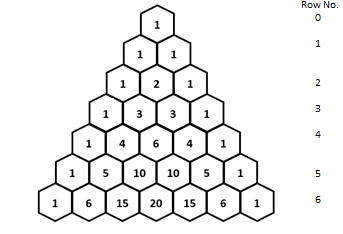
Every positive number will increase by one because the edges are formed of
Therefore, every positive integer appears in the Pascal’s triangle.
d.
To find: The result when adding and subtracting in any row.
The result when adding and subtracting in any row is equals to
Given information:
Consider the patterns in Pascal’s triangle.
Calculation:
The Pascal’s triangle is given by,

The numbers are identical on both sides if you cut the Pascal triangle in half down the middle.
As a result, the
Thus,
So, all row adds up to
Therefore, the result when adding and subtracting in any row is equals to
e.
To find: The interior numbers along the
The interior numbers along the
Given information:
Consider the patterns in Pascal’s triangle.
Calculation:
The Pascal’s triangle is given by,
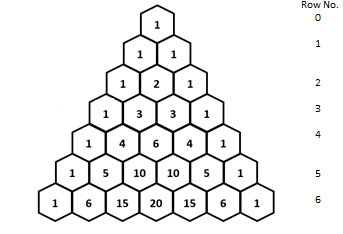
If the number were prime,
Therefore, the interior numbers along the
f.
To find: The rows that have all even interior numbers.
The rows that have all even interior numbers when the number is
Given information:
Consider the patterns in Pascal’s triangle.
Calculation:
The Pascal’s triangle is given by,
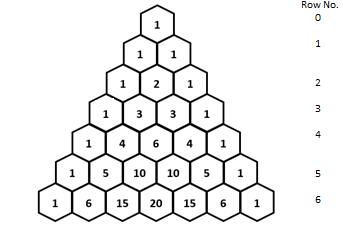
The row number must be a number that is
Therefore, the rows that have all even interior numbers when the number is
g.
To find: The rows that have all odd numbers.
The rows that have all odd numbers when it does not follow
Given information:
Consider the patterns in Pascal’s triangle.
Calculation:
The Pascal’s triangle is given by,
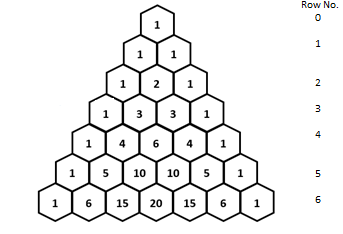
From part (f) it is known that the even interior numbers will follow
So, the odd interior number will not follow
Therefore, the rows that have all odd numbers when it does not follow
h.
To find: The other patterns in the Pascal’s triangle.
The other pattern obtained is a sum of
Given information:
Consider the patterns in Pascal’s triangle.
Calculation:
The Pascal’s triangle is given by,
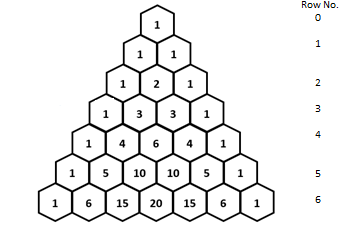
The top of Pascal's triangle has a
Additionally, it is observed that the positive integers are found on the second diagonal, which is slanted and located next to the side of the Pascal's triangle that contains all ones.
By adding all the numbers in the
Therefore, the other pattern is found by adding all the numbers in the
Chapter 9 Solutions
PRECALCULUS:GRAPHICAL,...-NASTA ED.
 Calculus: Early TranscendentalsCalculusISBN:9781285741550Author:James StewartPublisher:Cengage Learning
Calculus: Early TranscendentalsCalculusISBN:9781285741550Author:James StewartPublisher:Cengage Learning Thomas' Calculus (14th Edition)CalculusISBN:9780134438986Author:Joel R. Hass, Christopher E. Heil, Maurice D. WeirPublisher:PEARSON
Thomas' Calculus (14th Edition)CalculusISBN:9780134438986Author:Joel R. Hass, Christopher E. Heil, Maurice D. WeirPublisher:PEARSON Calculus: Early Transcendentals (3rd Edition)CalculusISBN:9780134763644Author:William L. Briggs, Lyle Cochran, Bernard Gillett, Eric SchulzPublisher:PEARSON
Calculus: Early Transcendentals (3rd Edition)CalculusISBN:9780134763644Author:William L. Briggs, Lyle Cochran, Bernard Gillett, Eric SchulzPublisher:PEARSON Calculus: Early TranscendentalsCalculusISBN:9781319050740Author:Jon Rogawski, Colin Adams, Robert FranzosaPublisher:W. H. Freeman
Calculus: Early TranscendentalsCalculusISBN:9781319050740Author:Jon Rogawski, Colin Adams, Robert FranzosaPublisher:W. H. Freeman
 Calculus: Early Transcendental FunctionsCalculusISBN:9781337552516Author:Ron Larson, Bruce H. EdwardsPublisher:Cengage Learning
Calculus: Early Transcendental FunctionsCalculusISBN:9781337552516Author:Ron Larson, Bruce H. EdwardsPublisher:Cengage Learning





